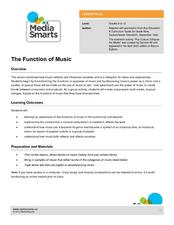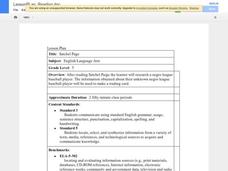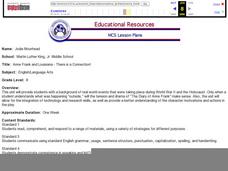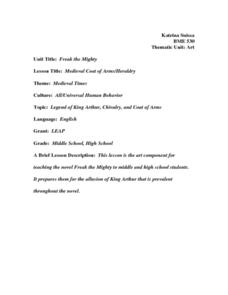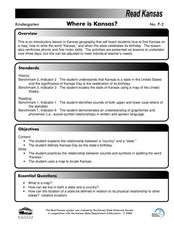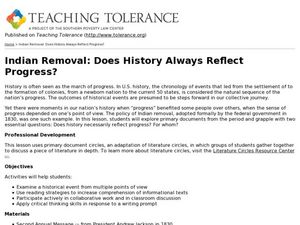Curated OER
Keepers
What are some things you think are special enough to keep? Discussing special things launches young learners into reading Keepers. They investigate related vocabulary and practice before, during, and after reading comprehension...
Curated OER
SPEECHES TO INTRODUCE
Pupils create multimedia speeches of introduction which focus on women and Hispanics. They introduce their famous person and, using a video camera, video tape their speeches.
Curated OER
Horse Character: Ceramics Lesson
Animals oftentimes elicit various characteristics which make them symbolic or representative of human feeling, action, or emotion. The class creates horse characters out of clay to show character action and symbolism. This is a great...
Curated OER
The Function of Music
Explore concepts of audience, purpose and symbols in this instructional activity from Media Smarts that asks students to consider all the functions of music. Through a series of discussions and activities, your class will brainstorm...
EngageNY
Analyzing Douglass’s Purpose
Class members continue analyzing text excerpts from Narrative of the Life of Frederick
Douglass. They read and draw conclusions to determine Douglass's view on slavery. Learners finish by discussing with partners how the excerpts...
EngageNY
Examples from Life Today
Does that happen in real life? Scholars look at their Themes of Adversity graphic organizers and think of examples in today's world for each type of adversity. They determine if today's world has the same struggles as those in the...
EngageNY
Researching: Eyewitness Accounts, Part 1
Time to go on a quote hunt! Because learners cannot interview real eye witnesses for their newspaper articles, they read through text The Great Earthquake and Fires of 1906 looking for quotes to answer their questions. Learners...
Curated OER
Modern Day Editing
Abigail Adams' letters reveal how the English language has changed and become more standardized over the last 200 years. To underscore this point, pupils edit one of Adams' letters
Curated OER
Satchel Page
Bring a lesson about Negro League Baseball to your Black history unit, or any other research unit throughout the year. While the lesson plan itself is simplistic, there are several good ideas that you could use, such as creating trading...
Curated OER
Anne Frank and Louisiana - There is a Connection!
How is Louisiana connected to the Holocaust? After reading The Diary of Anne Frank, eighth graders complete a research report about a survivor of the Holocaust who currently resides in Louisiana. Though the idea is a good way to...
Curated OER
Lines Of Connection
We need the help of your history detectives! After giving them a set of questions to answer, reading groups must create their own timeline of the events. Then, as a class, have each group present their timelines. What is different? Why...
Curated OER
The Star-Spangled Banner
Get your kids moving as they learn about the history of the United States National Anthem. Scholars examine the War of 1812, Francis Scott Key, and the meaning behind The Star Spangled Banner as they listen to an 18-minute...
Curated OER
Women
A close study of two works of art provides the introduction to this cross-curricular writing assignment. After comparing the clothing, facial expressions, body language, setting, and color in the two 19th century paintings Tissout’s...
Curated OER
Shamrock Spelling
Review spelling skills by learning about the history of shamrocks. Learners use a picture of a shamrock to practice spelling three letter words. One letter goes on each shamrock leaf. It is a way to engage your kinesthetic learners.
Curated OER
Hobbies
Memorize key phrases and grammar to practice speaking English. The class performs a sample dialogue, practice their vocabulary, and interview their classmates as a way to increase their English language proficiency.
Curated OER
History in the Making: The Tortilla
Fourth graders examine the history of the tortilla and extend the study across the curriculum. In this history of the tortilla lesson, 4th graders research the background of the tortilla, determine the ingredients, and work with the...
Curated OER
Medieval Coat of Arms/Heraldry
Students examine the history of Heraldry from medieval times in preparation for reading the novel "Freak the Mighty." They view and discuss examples of shields and discuss the color system and how shields were divided. As a culminating...
Curated OER
Baseball Memories
Students act as historians by, first, reading and analyzing oral histories of professional baseball players to become familiar with baseball figures. Then, they proceed to interview family members, relatives, or neighbors who have...
Curated OER
Four Foot Feat
Students examine cultural customs and practices in family histories. In this family history lesson, students read the poetry in 'All the Colors of the Race' to analyze the family history. Students complete guided reading activities....
Curated OER
Piercing the World of Silence
Students explore the sign language alphabet. They examine the difficulties faced by handicapped persons, and are introduced to Helen Keller, Anne Sullivan and The Miracle Worker.
Curated OER
Cartoons: How Have Society's Views of Women Changed Over Time?
Students explore women's rights by viewing cartoon images. In this women's history lesson plan, students view several images depicting women in a certain way while discussing the meaning of the imagery among their classmates. Students...
Curated OER
Where is Kansas?
Students explore U.S. Geography by analyzing a map. In this state vs. country lesson, students utilize a U.S. map and locate the state of Kansas before researching the history and customs of the state. Students collaborate as a class to...
Curated OER
Indian Removal: Does History Always Reflect progress?
Students explore the idea that progress for some might not mean progress for all. In this Native American lesson, students recognize different viewpoints about historical events through the study of primary documents. Students decipher...
Curated OER
Creating Identity Posters
Students discover the identities of their classmates. In this tolerance lesson, students create individual posters showcasing their identity, history, and family background. Students examine the posters to get a better...





